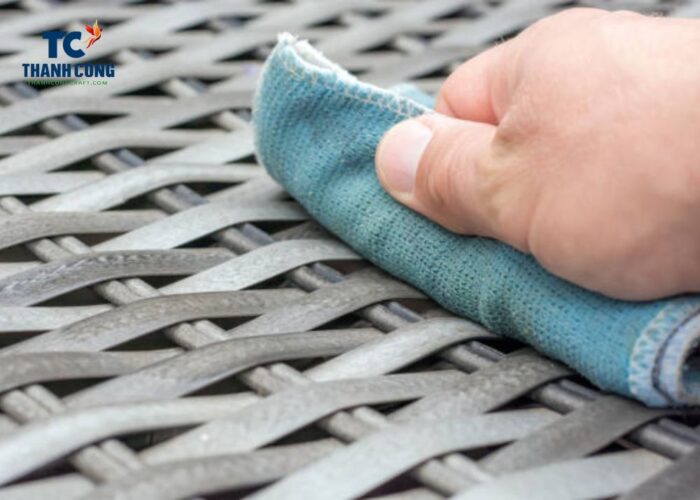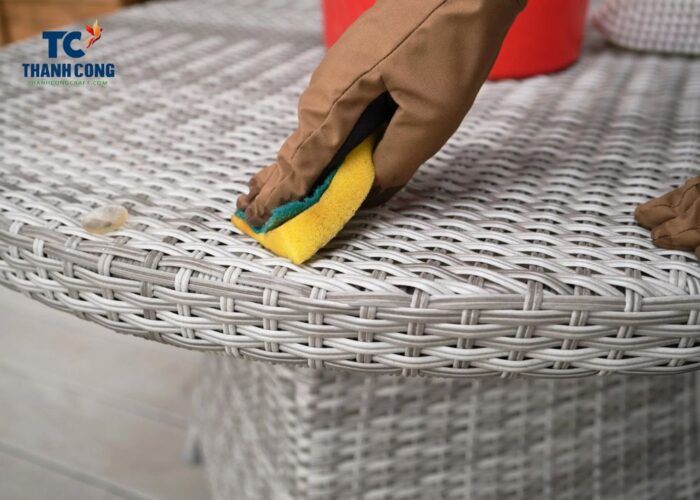Outdoor wicker furniture can get moldy and mildewy if exposed to rain and snow for a long time. These organisms not only cause aesthetic and odor problems, but can also damage your wicker furniture if not cleaned in time. To learn how to clean mold off rattan furniture, you can refer to the article below.
Contents
1. Why does wicker go moldy?
There are several causes of mold and dampness in woven rattan furniture, primarily due to the following two factors:
Inadequate wicker processing: After being harvested, the wicker needs to undergo processing and treatment to enhance the quality of the product. Currently, there are various methods available to protect wicker from wood-boring insects, such as using chemicals or water immersion.

Typically, the rattan is soaked in water for 3 to 5 months before being dried or air-dried. Wood-boring insects are a significant limitation for woven wicker products in general, especially in areas with a humid climate. Therefore, proper treatment for wood-boring insects is crucial in the production process of woven wicker lamps. If there are oversights in the rattan processing stage, issues such as mold and wood-boring insects are likely to occur.
High environmental humidity: Rattan is a highly absorbent wood material. Therefore, if it is placed in a high humidity environment, it is prone to wood-boring insects, mold, and rapid deterioration. The primary reason is that, before becoming a finished product, wicker must undergo a drying process, making it highly susceptible to absorbing moisture.
2. How to clean mold off rattan furniture?
To clean old mold off rattan furniture, you first need to prepare the following items: Soft bristle brush, Smaller detail brush or an old toothbrush, 2-3 microfiber cloths, Gentle dish soap, Bucket, Warm water, Hair dryer (optional), Bleach, Soap.
- Preparing the solution:
In a bucket or large bowl, mix 4 cups of warm water with 1 tablespoon of dishwashing soap. Stir thoroughly until you see foam forming on the surface. Have an additional bucket of clean water ready for rinsing the cloth during the cleaning process.
- Cleaning the furniture:
Submerge a cloth into the first bucket containing the cleaning solution and use it to clean the furniture. Rinse the cloth regularly in the second bucket while scrubbing away stubborn stains. For hard-to-reach areas, you can use a cloth wrapped around a toothbrush.

- Checking for cracks and mold:
Carefully inspect the wicker strands for any signs of cracks or mold after extended use. If you observe any, take immediate action to address these issues. Cracks and mold often occur in the legs and backs of the furniture.
- Removing mold:
If you discover any mold, create a solution by mixing bleach and clean water. Put on gloves, dip a soft cloth into the solution, and apply it to the affected areas. Then, move the furniture outside to dry in the sunlight as quickly as possible.

- Polishing the furniture:
Once you have completed all the previous steps and the furniture has dried completely, give it a final touch to achieve a shiny and polished look. Pour flaxseed oil into a small dish, dip a soft cloth into the oil, and wipe the wicker strands from top to bottom. Flaxseed oil will moisturize the wicker, preventing cracks and giving it a fresh and lustrous appearance.
3. FAQs
3.1 Can you use vinegar on rattan?
Yes, you can use vinegar on rattan furniture, but it should not be left on the surface for too long as it can damage the material. To clean rattan with vinegar, you need to dilute vinegar with warm water in a ratio of 1:4 and add a little dish soap. Then, you use a clean cloth or a soft brush dipped in the vinegar solution and gently wipe on the rattan surface. You should wipe in the direction of the rattan fibers to avoid scratching them and need to dry the rattan immediately after cleaning it with vinegar with a dry towel or a hair dryer.
3.2 Can you use bleach on rattan?
Using bleach on rattan furniture is generally not recommended. Bleach is a strong and harsh chemical that can potentially damage or discolor rattan material. It is best to avoid using bleach directly on rattan.
If you need to remove mold or mildew from rattan furniture, it is recommended to use a mild cleaning solution instead. You can create a mixture of mild dish soap and warm water. Gently scrub the affected areas with a soft cloth or sponge dipped in the solution. Rinse the cloth or sponge frequently and make sure not to oversaturate the rattan with water. Afterward, dry the rattan thoroughly to prevent any moisture-related damage.
If you have stubborn stains or mold that cannot be removed with mild cleaning methods, it is best to consult a professional or follow the manufacturer’s recommendations for specific cleaning instructions for your rattan furniture.
3.3 How do you prolong the life of rattan furniture?
To prolong the life of rattan furniture, you can follow these tips:
- Place your rattan furniture in areas where it is shielded from direct sunlight and extreme weather conditions. Sunlight exposure can cause the rattan to become brittle and fade over time. Use a furniture cover or move it indoors during harsh weather.
- Rattan is vulnerable to damage from excess moisture, so avoid placing it in damp or humid environments. Clean up any spills promptly, and make sure it is dry after cleaning.
- Clean your rattan furniture regularly to remove dust and dirt. Use a soft brush or cloth to gently remove debris. Use a mild soap solution or a mixture of gentle dish soap and warm water to clean rattan. Avoid harsh abrasives or chemicals that can damage the material.
- Use furniture pads or felt protectors on the legs to prevent scratches and dents when moving or placing items on it. Avoid dragging heavy objects across the rattan surface.
- Check and tighten any loose or wobbly parts of the furniture regularly. This will help maintain the structural integrity of the rattan.
- If you are not using the rattan furniture for an extended period, store it in a cool, dry, and well-ventilated area. Consider covering it with a breathable material to protect it from dust and dirt
Cleaning mold off rattan furniture is crucial for maintaining its beauty and durability. By following these steps and taking preventive measures, you can effectively remove mold and keep your rattan furniture in excellent condition for years to come.
If you have any further questions, please don’t hesitate to contact Thanhcongcraft via email: info@thanhcongcraft.com or Tel/WhatsApp: +84967485411. Hope to serve you soon! Best regard!












